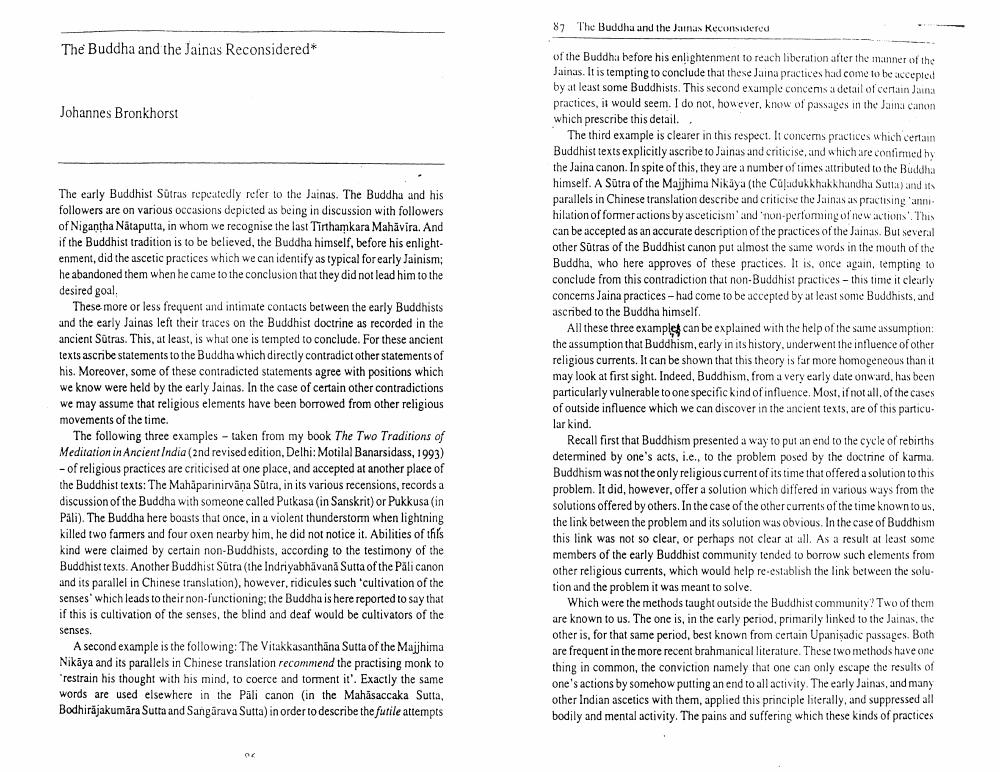Book Title: Buddha And Jainas Reconsidered Author(s): Johannes Bronkhorst Publisher: Johannes Bronkhorst View full book textPage 1
________________ 87 The Buddha and the Jamnas Keconsidered The Buddha and the Jainas Reconsidered* Johannes Bronkhorst The early Buddhist Sutras repeatedly refer to the Jainas. The Buddha and his followers are on various occasions depicted as being in discussion with followers of Nigantha Nataputta, in whom we recognise the last Tirthamkara Mahavira. And if the Buddhist tradition is to be believed, the Buddha himself, before his enlightenment, did the ascetic practices which we can identify as typical for early Jainism; he abandoned them when he came to the conclusion that they did not lead him to the desired goal, These more or less frequent and intimate contacts between the early Buddhists and the early Jainas left their traces on the Buddhist doctrine as recorded in the ancient Sutras. This, at least, is what one is tempted to conclude. For these ancient texts ascribe statements to the Buddha which directly contradict other statements of his. Moreover, some of these contradicted statements agree with positions which we know were held by the early Jainas. In the case of certain other contradictions nay assume that religious elements have been borrowed from other religious movements of the time. The following three examples - taken from my book The Two Traditions of Meditation in Ancient India (2nd revised edition, Delhi: Motilal Banarsidass, 1993) - of religious practices are criticised at one place, and accepted at another place of the Buddhist texts: The Mahaparinirvana Sutra, in its various recensions, records a discussion of the Buddha with someone called Putkasa (in Sanskrit) or Pukkusa (in Pali), The Buddha here boasts that once in a violent thunderstorm when lightning killed two farmers and four oxen nearby him, he did not notice it. Abilities of this kind were claimed by certain non-Buddhists, according to the testimony of the Buddhist texts. Another Buddhist Sutra (the Indriyabhavana Sutta of the Pali canon and its parallel in Chinese translation), however, ridicules such cultivation of the senses' which leads to their non-functioning the Buddha is here reported to say that if this is cultivation of the senses, the blind and deaf would be cultivators of the senses. A second example is the following: The Vitakkasanthāna Sutta of the Majjhima Nikāya and its parallels in Chinese translation recommend the practising monk to restrain his thought with his mind, to coerce and tomment it'. Exactly the same words are used elsewhere in the Pali canon (in the Mahāsaccaka Sutta, Bodhirajakumāra Sutta and Sangūrava Sutta) in order to describe the futile attempts of the Buddh before his enlightenment to reach liberation after the manner of the Jainas. It is tempting to conclude that these Jaina practices had come to be accepted by at least some Buddhists. This second example concenisa detail of certain Jana practices, it would seem. I do not, however, know of passages in the Jaina canon which prescribe this detail. The third example is clearer in this respect. It concerns practices which certain Buddhist texts explicitly ascribe to Jainas and criticise, and which are contimed by the Jaina canon. In spite of this, they are a number of times attributed to the Buddha himself. A Sūtra of the Majjhima Nikaya (the Culudukkhakkhandha Sullt) and its parallels in Chinese translation describe and criticise the Jainas as practising anni hilation of former actions by asceticism' and non-performing of new actions. This can be accepted as an accurate description of the practices of the Jainas. But several other Sutras of the Buddhist canon put almost the same words in the mouth of the Buddha, who here approves of these practices. It is once again, tempting to conclude from this contradiction that non-Buddhist practices - this time it clearly concerns Jaina practices - had come to be accepted by at least some Buddhists, and ascribed to the Buddha himself. All these three example can be explained with the help of the same assumption: the assumption that Buddhism, early in its history, underwent the influence of other religious currents. It can be shown that this theory is far more homogeneous than it may look at first sight. Indeed, Buddhism from a very early date onward, has been particularly vulnerable to one specific kind of influence. Most, if not all of the cases of outside influence which we can discover in the ancient texts, are of this particu. lar kind. Recall first that Buddhism presented a way to put an end to the cycle of rebirths determined by one's acts, i.e., to the problem posed by the doctrine of karma, Buddhism was not the only religious current of its time that offered a solution to this problem. It did, however, offer a solution which differed in various ways from the solutions offered by others. In the case of the other currents of the time known to us, the link between the problem and its solution was obvious. In the case of Buddhism this link was not so clear, or perhaps not clear at all. As a result at least some members of the early Buddhist community tended to borrow such elements from other religious currents, which would help re-establish the link between the solu tion and the problem it was meant to solve. Which were the methods taught outside the Buddhist community? Two of them are known to us. The one is, in the carly period, primarily linked to the Jainas, the other is, for that same period, best known from certain Upanişadic passages. Both are frequent in the more recent brahmanical literature. These two methods have one thing in common, the conviction namely that one can only escape the results of one's actions by somehow putting an end to all activity. The early Jainas, and many other Indian ascetics with them, applied this principle literally, and suppressed all bodily and mental activity. The pains and suffering which these kinds of practicesPage Navigation
1 2 3
